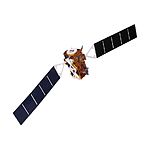SEOSat-Ingenio
| Mission type | Optical imaging Disaster monitoring |
|---|---|
| Operator | Airbus Defence and Space |
| Mission duration | Seven years[1] |
| Spacecraft properties | |
| Manufacturer | Airbus Defence and Space |
| Launch mass | 830 kg |
| Dry mass | 750 kg |
| Power | 580 W |
| Start of mission | |
| Launch date | End of 2016[2] |
| Orbital parameters | |
| Reference system | Polar |
| Regime | Sun-synchronous |
| Apogee altitude | 668 km |
Ingenio (or SEOSat/Ingenio) is a Spanish project to produce a satellite capable of providing wide-field imagery (230 60km x 60km frames a day) at 2.5m panchromatic resolution and 10m colour resolution, from the classic 'spy satellite' sun-synchronous polar orbit; it is Spain's first optical imaging satellite. The satellite is part of the Spanish Earth Observation Satellite program.[3]
The prime contractor is Airbus Defence and Space Spain[1] and some parts of the satellite are being built by Thales Alenia Space [4]
It is projected to launch at the end of 2016, launch vehicle candidates are: Vega, Rockot, Dnepr, Soyuz, and PSLV.[2]
On board instruments feature a Multispectral imager, a Panchromatic Imager and a Ultraviolet and Visible Atmospheric Sounder.[3]
References
- ^ a b "INGENIO: the first Spanish optical Earth observation satellite". Airbus Defence and Space. Retrieved 22 July 2015.
- ^ a b "SEOSat/Ingenio - Earth Observation Satellite of Spain". ESA. Retrieved 22 July 2015.
- ^ a b "Satellite: SEOSat/Ingenio". World Meteorological Organization. 30 May 2014. Retrieved 22 July 2015.
- ^ "SEOSAT INGENIO" (in Spanish). Thales Alenia Space. 31 October 2008. Retrieved 22 July 2015.

